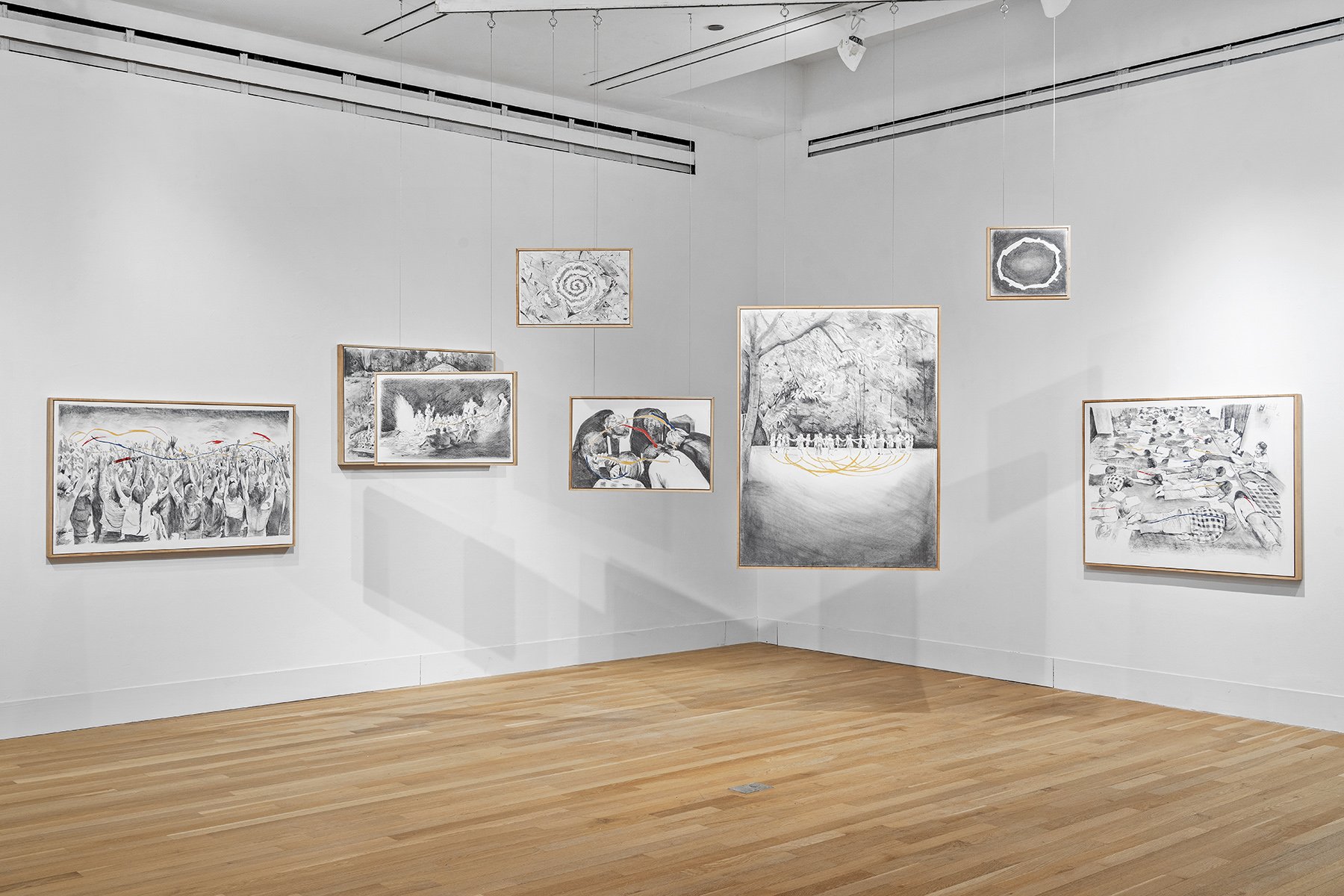REVIEW: Ali Feser and Heather Kai Smith: Pawing the Ground In Place at the Reva and David Logan Center for the Arts
Installation view, Ali Feser and Heather Kai Smith: Pawing the Ground in Place," Reva and David Logan Center for the Arts. Photo: Robert Chase Heishman.
REVIEW
Ali Feser and Heather Kai Smith: Pawing the Ground in Place
Jan. 20 - March 5
Logan Center Exhibitions
Reva and David Logan Center for the Arts
915 E 60th St.
Chicago, IL 60637
By Noah Karapanagiotidou
In this two-woman show, Heather Kai Smith and Ali Fesser explore iterations of utopia and the medium of photography through drawing, print, projection, and installation. The exhibition spans across two rooms in the Logan Center’s gallery. Three of the walls of the main room of the exhibition are occupied by Heather Kai Smith’s drawings and prints. This collection of work is moving, hopeful, and utopian. The series of 28 drawings, titled Variations on idiorrhythmy, depict themes of interpersonal closeness, collective action, mutual aid, and group fun. The compositions of the drawings are very photographic, with some having a vignette and some having a white border. Negative space often delineates the highlights. All but two of the drawings denote groups of people, ranging from three to uncountable crowds.
None of the drawings seem to include any form of hierarchical structure, as all the individuals pictured are involved at the same level. People are arranged in circles, pyramids, huddles, lines, crowds, and a variety of other formations. There is a lot of movement captured in this series of drawings which adroitly visually harnesses the potential that can exist within co-ordination and collaboration between people. Five of the drawings are suspended from the wall in the corner that joins the two walls of drawings, making the overall presentation rounded and circular, which sits nicely with the themes captured in the work. The drawings vary in size and are all graphite on mounted paper with some having one, two or three primary colors in colored pencil. The primary colors are introduced in the form of lines or threads that highlight the connective lines running between the people pictured.
Installation view, (We Put The Clouds In The Sky), We Can Take Them Away at Ali Feser and Heather Kai Smith: Pawing the Ground in Place," Reva and David Logan Center for the Arts. Photo: Robert Chase Heishman.
Smith’s cyanotype prints include very similar thematic and compositional content, but all include some form of dance. The bodies of people are outlined through negative space, providing them with a strong glow against the blue ink, suggesting a positive force that lives within these people.
On the fourth wall of the main exhibition room hangs Ali Feser’s Dream Machine. This consists of four floor-to-ceiling translucent banners of chiffon on which are printed various layers of rectilinear shapes. The shapes are arranged somewhat irregularly and are overwhelmingly warm toned with the exception of a few greens and blues. This piece more explicitly references photography as the prints were made using collaged Kodak negatives and include some text elements to evidence this. This piece posits an untraditional use of film photography to create abstract colorful compositions, while simultaneously capturing and questioning the illusory and somewhat fantastical nature of the photographic medium.
Installation view, Ali Feser and Heather Kai Smith: Pawing the Ground in Place," Reva and David Logan Center for the Arts. Photo: Robert Chase Heishman.
The smaller room is dark and contains Ali Feser’s installation (We Put The Clouds In The Sky), We Can Take Them Away. The installation consists of a wood panel with small rectilinear holes of varying lengths and widths and various heights on the wall to accommodate the peeping of viewers of all heights. Through the holes there is an installation of projectors pointed towards the viewer, with projections on the two walls. The wood panel presumably has mirrors on it that project the projections onto the walls that the viewer can see. The projections show a series of photographs of the sky, interspersed with some abstract photos and bodies of water. This disorienting positioning of the projectors and projection plays with the viewer’s sense of viewership and vantage point in an interesting way.
Feser and Smith’s works live synergistically in the gallery room, with starkly different levels of interpretive opacity: while Smith’s work is unabashedly direct and utopian, Feser’s is more puzzling. This is fitting, as Smith’s work seems to be inviting viewers to dream of the positive potential that lies within people and their connections, while Feser’s encourages viewers to trouble their understandings of photography and its entanglements with consumer capitalism.
Like what you’re reading? Consider donating a few dollars to our writer’s fund and help us keep publishing every Monday.




